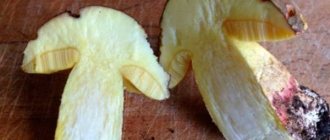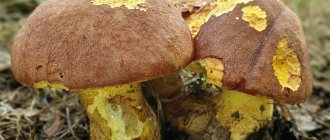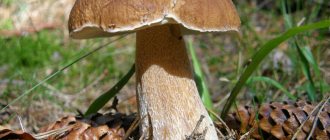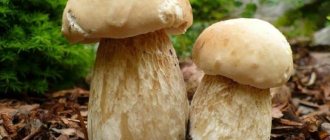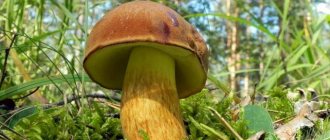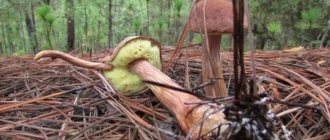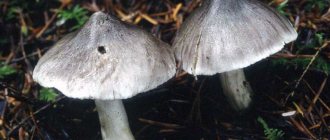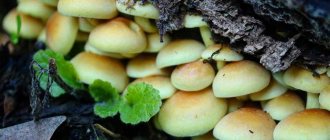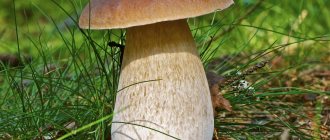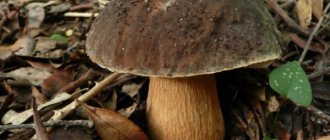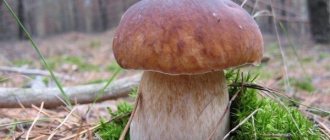We are accustomed to the fact that boletus mushroom is a noble, tasty and always desired prey on a quiet hunt. But, alas, this is not always the case. Boletus root can be a bitter disappointment for mushroom lovers - both literally and figuratively. All the benefits that can be derived from this species, which belongs to the genus Bolethus, boils down to purely aesthetic pleasure, and perhaps even a few spectacular shots. This mushroom cannot be eaten because of its ineradicable bitterness.
Beautiful-legged boletus: where it grows, what it looks like, edibility, how to distinguish it, photo
The beautiful-legged boletus (lat. Caloboletus calopus or Boletus calopus), also the beautiful or inedible boletus is a fairly common mushroom, which is distinguished by the bright color of the leg. As the name of the species suggests, the fruiting bodies should not be eaten.
What beautiful-legged boletes look like
The cap of the beautiful-legged boletus can grow up to 6-14 cm in diameter, while in appearance it is completely inconspicuous, which strongly contrasts with the bright stem of the mushroom.
Its color varies from grayish-olive to light brown. The cap is smooth to the touch, but matte and dry.
In young specimens it has the shape of a hemisphere, however, in mature boletes it opens up and becomes convex. The edges of the cap curl downward as the fruiting body grows.
When cut, this species turns blue within 5-8 minutes.
The spores of the fungus are brownish-olive.
The stem of the boletus has the shape of a barrel in young mushrooms. At the next stage of development, it becomes club-shaped, and in mature specimens it acquires a cylindrical appearance. The height of the leg is on average 5-15 cm, diameter - 2-5 cm. Under the cap itself it is whitish-yellow, but this color quickly turns into a rich red. In mature boletes, the stem is brownish at the bottom.
Important! One of the distinctive features of the beautiful-legged boletus is the presence of a fine mesh of whitish or light yellow color, which covers almost the entire leg. The pulp of the fruiting bodies is quite dense, even hard
It is painted in cream shades and does not have a pronounced odor.
The pulp of the fruiting bodies is quite dense, even hard. It is painted in cream shades and does not have a pronounced odor.
Where do beautiful-legged boletes grow?
The distribution area of the beautiful-legged boletus includes coniferous forests of mountainous regions. Most often, small groups of mushrooms can be found near spruce trees. Solitary ones are occasionally found in deciduous and mixed forests.
The preferred type of soil is sandy with a high level of acidity. On the territory of Russia, the beautiful-legged plant grows in southern latitudes.
Important! The fruiting period is from July to October. In warm years it lasts until November
The beautiful-legged boletus is an inedible mushroom, however, the reasons for this definition may vary greatly in the reference literature. Some authors note that its pulp does not contain toxic substances, but it should not be eaten because of its strong bitterness. The sharp unpleasant taste does not disappear even after 10 hours of soaking or frying.
Other sources claim that the beautiful leg is poisonous. Toxic components in its pulp can cause severe intestinal upset, convulsions and even loss of consciousness. After some time, the victim begins to develop cirrhosis of the liver.
Sometimes there are white streaks on the lower part of the leg (near the ground)
Important! The beautiful-legged boletus is similar to the satanic boletus - a very poisonous mushroom. They are distinguished mainly by their spores - in the satanic mushroom they are rich red in color
They are distinguished mainly by their spores - in the satanic mushroom they are rich red in color.
Symptoms of poisoning
The first signs of poisoning begin to appear within 2-3 hours after eating the fruiting bodies. Characteristic symptoms include the following changes:
- causeless weakness, trembling in the hands;
- dizziness;
- nausea, vomiting;
- diarrhea (sometimes with blood);
- Strong headache;
- convulsions;
- muscle pain.
If a large amount of toxic substances enters the body, it can lead to loss of consciousness.
Important! Another symptom of poisoning with beautiful leg boletus appears after 1-2 weeks - by this time the toxins that have entered the human body begin to destroy liver cells. If first aid is not provided in time, poisoning can lead to cirrhosis.
It is also necessary to artificially induce vomiting in the victim - to do this, he is given a glass of soda solution diluted in the proportion of 1 tsp. for 0.5 liters of water.
Conclusion
Despite its attractive appearance, it is impossible to collect beautiful-legged boletus - the mushroom is inedible and even poisonous, according to some sources. Opinions about the toxicity of this disease differ among different authors, however, everyone notes the strong bitterness in the pulp of the fruiting bodies. It is impossible to get rid of it even after prolonged soaking and heat treatment.
The danger of the beautiful-legged boletus also lies in the fact that an inexperienced mushroom picker may confuse some edible varieties with it. If you have the slightest suspicion that the find is a poisonous mushroom, you should leave it alone.
You can learn more about what the beautiful-legged bolete looks like from the video below:
Is it possible to eat it?
The semi-white mushroom is edible. Moreover, it is very tasty. It can be safely boiled, fried, pickled and dried. All preparations are good in their own way. After heat treatment, the specific iodine smell disappears, and the pickled mushrooms turn out simply excellent.
Yellow bolet can be frozen for the winter. First of all, the mushrooms are soaked and after a few hours they are cleaned of dirt and soil. Then they are thoroughly washed, cut into pieces, placed in boiling water and cooked until tender in salted water. Next, the mushrooms must be discarded in a colander to drain excess moisture. Pack into bags and place in the freezer.
Rooting Boletus: edible or not
The root boletus, or as it is also called the stocky boletus, is an inedible species of boletus that grows in coniferous and deciduous forests. It prefers acidic and sandy soils. It is not eaten because it has a bitter taste that cannot be eliminated even after prolonged heat treatment. This species bears fruit from July to October.
Description of root boletus
Types of mushroom
The genus Boletus (Boletus) includes many edible and inedible species, among which there are white, beautiful, bronze, beautiful-legged and other varieties. Both the rooting, or whitish, mushroom and species b. handsome and b. beautiful belong to the inedible category.
- Porcini mushroom: edible species. The color of the cap corresponds to the name, but can be dark. Its diameter can reach 26 cm in the presence of favorable conditions for development, its surface is dry and velvety to the touch. The pulp is light and dense, does not change color and has no odor. The leg is up to 18 cm long and has a cylindrical shape. Spore powder is brown-olive.
- Bronze boletus: classified as edible. The pulp softens with age, has a uniform structure, noticeably darkens when cut, and has a weak taste and aroma. The height of the leg is small.
- Semi-white mushroom, or yellow boletus: an edible mushroom, the color of its flesh does not change when cut. It has a characteristic, although faint, odor of carbolic acid at the base of the stalk. The diameter of the cap grows to 22 cm, the shape varies from round and convex to flat and rising.
- Beautiful boletus: a species included in the inedible category. The diameter of the cap ranges from 8 to 30 cm, its shape is hemispherical, and the surface is woolly. Color varies from red to brown-olive. The pulp is yellowish, noticeably blue when cut. The height of the leg is up to 15 cm, its diameter is up to 7 cm maximum. The leg is rough to the touch, the base is covered with a small pile. This mushroom is used in cooking for pickling.
- Boletus boletus: a representative of the group of inedible mushrooms. It has a light brown or brownish-olive upper part of the cap, its surface is wrinkled, and the edge is wavy. The pulp is light and dense, turning blue when damaged. The tubes on the lower surface are yellow, when cut they become blue. The length of the leg is up to 15 cm. This inedible mushroom grows on soils with high acidity, its upper part reaches 16 cm, its shape resembles half a ball, but it changes with age. The covering tissue feels different to the touch. Its color is brownish-olive or brownish-gray. The leg is dense and acquires a red tint towards the base.
Boletus has many edible and inedible species
- Wolf's boletus, or false satanic mushroom: it is classified as a conditionally edible mushroom. It is characterized by a cap with a diameter of 10 to 20 cm. In young representatives it is semicircular, becoming prostrate with age. The covering tissue has a red or pink tint. Young specimens are light, but with aging they noticeably darken within their color range. The skin is dry, with a felt coating on top. The flesh is light yellowish, similar to the stocky boletus, and has a dense structure. The leg is cylindrical, only up to 8 cm long, so it is considered short. The surface of the leg is painted bright yellow and narrowed at the bottom.
- Golden boletus: classified as edible mushrooms, representatives of the species have a slightly smaller cap than the species described above, but its shape changes from convex to almost flat. At a young age, its skin is smooth and velvety, but as it ages, it noticeably cracks. The hymenophore is also a yellow tube. The color hardly changes when touched. The length of the tubes is no more than 3 cm. The length of the leg reaches 25 cm, it is narrowed at the top. This part of the mushroom is thin and elastic, with a typical mesh pattern.
Places of growth
For boletus to grow, it requires a warm climate and a predominantly deciduous forest, dominated by oak and birch groves. In rare cases, it can be found in mixed forests or coniferous forests, where they are practically not found. These mushrooms prefer dry neutral or calcareous soils.
Places where this representative is often found are North American European and African countries. Boletus bears fruit from July to October.
Gorchak is an inedible double of Bely. Satanic mushroom. Be careful!!!
Conclusion
Rooting boletus is an inedible mushroom. It is not used in either medical or culinary practice. The variety has no value as such. Representatives of the species are characterized by the presence of many similar boletus species.
What types of porcini mushrooms are there?
The porcini mushroom (lat. Bolétus edúlis) is the beauty and pride of our forests. And not ours either. Apparently, in order for everyone to have enough happiness, the fungus is distributed almost throughout our large country where there are trees, since it is a mycorrhiza-former. That is, the mycelium settles in the roots of the plant, receiving carbohydrates and amino acids from it, in turn making water and phosphorus compounds more accessible to the tree.
The porcini mushroom prefers to coexist with spruce, pine, oak, and birch. But it can also get along with other coniferous and deciduous trees if there are no favorite trees in the vicinity, and these mushrooms cannot grow.
They look different in different forests, camouflaging themselves in local foliage, grass and landscape features. For this, scientists (ours, not the British) divided them into different forms, numbering about two dozen.
As most often happens, mycologists do not have a consensus on the number of forms and species; mushrooms periodically move from one classification section to another, but this in no way affects mushroom pickers. And it won't be reflected. Because the porcini mushroom in all its varieties is white: it has a white stem and cap flesh that does not change color when cut. No matter how you press it, bluish and pinkish spots do not form on it. Clean and white. The tubular layer (bottom of the cap) is white at a young age, yellow at an average age, and greenish at an advanced age.
The smell of raw mushroom is described in different ways in the literature, most often as weak. But to me it seems quite noticeable, mushroomy, pleasant. And during heat treatment and drying it opens up to its full potential.
In all places and types, the mushroom captivates with its solidity: a wide, stable stem and a thick, tightly fitting cap. At the same time, the color of the cap can be very different within the range of creamy-yellow-brown tones.
The porcini mushroom is a good family man: it’s worth hanging around what you find for a while - you’ll definitely find relatives of different ages, from pot-bellied small fry to wormy patriarchs. Unless, of course, competitors have already been here.
Young porcini mushroom in section. wnYoung porcini mushroom in section. wallpaperflareElderly white mushroom
Description of the bronze bolet
The diameter of the cap of this large mushroom is 7-17 centimeters, but there are huge specimens whose caps reach up to 40 centimeters in diameter. In this case, the thickness of the cap is 2-4 centimeters. The shape of the cap at a young age is convex, almost spherical, but over time it becomes prostrate. The surface of the caps of young fruiting bodies is smoother, but later dimples and depressions appear; they are located irregularly, and become more numerous towards the edge.
The color of the caps of young mushrooms is dark chestnut and even almost black, with areas with a whitish coating. Such zones are the main distinguishing feature of the bronze boletus. With age, the caps become lighter, the color changes in spots and becomes copper-brown or intense chestnut. In young mushrooms, the edges of the caps are uneven, but over time they straighten out. The surface of the cap is not mucous even in wet weather.
Tubes adherent to the stem. The color of the tubes is white or gray-white, but with age it becomes cream or pale yellow, and then completely yellow-olive. When pressure is applied to the tubes, they darken. The pores are angular in shape, measuring 3 by 1 millimeter. The spores are fusiform, thin-walled, smooth, and contain one or several drops of fat. The color of the spores is pale ocher, the spore powder is olive-brown.
The length of the leg is 9-12 centimeters and the thickness is 2-4 centimeters. The shape of the leg is club-shaped or tuberous; in adulthood it becomes cylindrical. The surface of the leg is slightly wrinkled. The structure of the leg is rigid. Its color varies from light pink-beige to olive-beige; at a young age, the legs can be almost white. The upper part of the leg is reticulated white, and the lower part of the leg is almost brown.
The flesh of the caps of young specimens is uniform, hard, and wine-colored. With age, the pulp becomes softer and pales to white, but above the tubes it retains a yellowish tint. The flesh of the leg is homogeneous and darkens at the break. The smell and taste of the pulp are soft.
Distribution of bronze boletes
These are rare mushrooms; they grow in mixed forests. They prefer humus, moist soils. Bronze boletes are widespread mainly in the south of our country. They bear fruit in summer and early autumn.
Similarities between bronze boletes and other mushrooms
The Polish mushroom is somewhat similar in appearance to the bronze boletus; these mushrooms can be confused by beginners. But the Polish mushroom does not have a mesh on its stem, and the flesh may turn blue when cut.
White pine mushroom, which is considered to be of very high quality, can also be confused with bronze bolet. But white pine mushrooms are more common; they are distinguished by brown-red or wine-red caps and larger sizes. In addition, white pine mushrooms live exclusively in coniferous forests.
The semi-bronze bolet can also be confused with its relative, but it has a lighter colored cap and grows in mixed and deciduous forests.
How to store
The semi-white mushroom is a universal mushroom. After preliminary soaking and boiling, it loses its unpleasant odor and, according to some mushroom gourmets, is in no way inferior in taste to porcini mushroom. Based on this, the semi-white mushroom is suitable for preparing any types of preparations for the winter, including freezing. It has proven itself well in canning, both as a mono component and as part of vegetable stews.
Important! During the drying process, the semi-white mushroom loses its unpleasant “medicinal” smell.
The easiest and most trouble-free way to preserve semi-white mushrooms for use out of season is drying. In this case, there is no need to wash or boil the mushrooms first; it is enough to clean them properly. In order for the fruiting bodies to dry evenly, they are cut into pieces of the same size, strung on a thread and dried in the open air. An oven, oven or electric dryer is also used for these purposes.
Ready-made, properly dried mushrooms do not release liquid, are elastic, and do not break or crumble when bent. At room temperature, the shelf life of semi-white mushroom (dried) is up to six months.
Many people are interested in whether and how to store semi-white mushrooms in the freezer. Freezing allows you to obtain a semi-finished product that is immediately ready for main culinary processing. Raw semi-white mushrooms are not suitable for this type of preparation; they must be pre-soaked and boiled. Mushrooms prepared in this way are placed in containers or zip bags and frozen. The frozen shelf life of semi-white mushroom is 6 months.
Important! Since repeated freezing of mushrooms leads to a deterioration in their quality, prepared mushrooms should be frozen, divided into portions, so that one is enough to prepare one dish.
And, of course, the semi-white mushroom is salted and pickled, and, according to fans of mushroom cooking, it is in its pickled form that it reveals its flavor characteristics to the fullest.
Rooting boletus (Caloboletus radicans)
Other names for the mushroom: Stumpy boletus, deep-rooting boletus, whitish boletus, rooting boletus
Other names:
Photo by: I. Assyova
External description
The cap is 6-20 cm in diameter, occasionally reaching 30 cm, in young mushrooms it is hemispherical, then convex or cushion-shaped, the edges are initially bent, in mature specimens they are straightened and wavy. The skin is dry, smooth, whitish with grey, light fawn, sometimes with a greenish tint, and turns blue when pressed.
The hymenophore at the stem is depressed, the tubes are lemon-yellow, then olive-yellow, turning blue when cut. The pores are small, round, lemon-yellow, and turn blue when pressed.
Spore powder is olive-brown, spores size 12-16*4.5-6 microns.
The stalk is 5-8 cm high, occasionally up to 12 cm, 3-5 cm in diameter, tuberous-swollen, cylindrical in maturity with a tuberous base. The color is lemon yellow at the top, often with brown-olive or bluish-green spots at the base. The upper part is covered with an uneven mesh. Turns blue when cut, acquires an ocher or reddish tint at the base
The pulp is dense, whitish with a blue tint under the tubes, and turns blue when cut. The smell is pleasant, the taste is bitter.
Spreading
The root boletus is common in Europe, North America, and North Africa, although it is not common everywhere. It is a heat-loving species, prefers deciduous forests, although it is found in mixed forests; it often forms mycorrhiza with oak and birch. Rarely seen, from summer to autumn.
Similarities
The root boletus can be confused with the satanic mushroom (Boletus satanas), which has a similar cap color, but differs from it in its yellow tubes and bitter taste; with the beautiful boletus (Boletus calopus), which has a reddish leg in the lower half and is distinguished by an unpleasant odor.
Grade
Boletus rootis Inedible due to its bitter taste, but is not considered poisonous. In Pelle Jansen's good reference book, All About Mushrooms, it is mistakenly listed as edible, but the bitterness does not disappear when cooked.
Boletus root mushroom
from questions in recognition:
| Type of mushrooms: | inedible |
| Other names (synonyms): | Boletus stocky, Boletus deep-rooting, Boletus bitter spongiosa, Boletus rooting, Boletus bitter spongiosa |
| Latin name: | Boletus radicans |
| Family: | Boletaceae |
| Distinctive feature: | Boletus radicans is a large and rare mushroom that is inedible and can cause severe vomiting and diarrhea. |
| Beginning of the season: | June |
| End of season: | September |
| Leg height (cm): | 5-14 |
| Cap width (cm): | 10-15 |
| Smell: | weak but unpleasant |
| Taste: | pleasant, but after a long chewing - bitter. |
| Tasting score: | – |
| Hat: | at first hemispherical, later expanded, and also cushion-shaped, irregularly pitted, whitish to light beige, or even gray, green-bluish under pressure, later brownish, in the dry period the surface is cracked, the edge is thin. |
| Leg: | 4-7 cm thick, at first bulbous, later club-shaped, the base is pointed and rooted, in youth it is light yellow in color and covered with a yellow mesh, in old age with a brownish-yellowish and brownish mesh. Under pressure it is bluish, on the upper side the flesh is light yellow and bluish, the lower side is light pink, brownish, but not bluish, full and continuous. |
| Hymenophore (bottom of cap): | bright lemon or golden yellow, later olive to brownish yellow, bluish under pressure. |
| Disputes: | dark olive with a brown tint, elliptical-spindle, with drops, 11.4-14.8 x 5.3-7.6 microns. |
| Pulp: | whitish, light yellowish, if cut it turns pale immediately. |
| Natural environment and mycorrhiza: | in groups or solitary in coniferous forests, parks, on dry and calcareous or rich soils. |
| False doubles: | edible: Boletus mushroom, which has a cone-shaped leg, pointed at the bottom, a cap of a darker color, Semi-white mushroom - does not change color when cut, the color is slightly darker, in its raw form - has a characteristic smell of carbolic acid. Among the inedible: Inedible boletus (Boletus calopus), which is distinguished by a brighter colored stem, grows in acidic fertile soils. |
| Growing: | – |
| Use: | – |
| Medicinal properties: | – |
| Spreading: | in the south of England and other parts of Europe |
The root boletus is not so often found in the forest, but its appearance can deceive even an experienced mushroom picker. Bolet has similarities with many valuable representatives of the forest kingdom, so it is worth paying close attention to its description. Find out how to distinguish the bitter sponge boletus and familiarize yourself with its characteristics.
Interesting Facts
Boletuses in general belong to the category of the largest mushrooms in the world. Their weight can exceed 3 kilograms!
Experienced mushroom pickers have noticed an interesting feature: fly agarics begin to appear in the forest at the same time as boletus mushrooms. Therefore, if you encounter a representative of the fly agaric family near a tree, you can safely look for and find a tasty bolet. Another sign of the proximity of an edible boletus is the presence of an anthill.
The bitter sponge boletus is an inedible representative of the forest kingdom; they have not yet learned how to use it either in medical practice or in culinary practice. A mushroom picker should know a detailed description of this species so as not to confuse it in the forest with other edible boletus mushrooms.
Description of root boletus
The appearance of the root boletus is the same as that of most other boletus. The diameter of the rooting boletus cap is 6-30 centimeters. At first, the shape of the cap is hemispherical, but in old mushrooms it is slightly convex with protruding leathery edges. The color of the cap is whitish, dirty gray or brownish gray. The surface of the cap is slightly rough, often cracking. The color of the root boletus is similar to the satanic mushroom from the same family.
The pulp is yellow-lemon in color, but when cut it becomes bluish, especially in the stem. The taste of the root boletus is unpleasant, bitter, and the smell is weak. The milky juice is also bluish.
The length of the leg is 8-12 centimeters, and the width is 3-5 centimeters. The shape of the leg is slightly swollen, with age it becomes cylindrical with a tuberous base. The color of the leg is dull yellow or lemon yellow, the lower part has a brown-olive tint, and the upper part is whitish. Sometimes there may be a thin, uniform white network, due to which the root boletus is confused with the satanic mushroom.
The tubular layer is pressed tightly against the leg. The color of the tubes is light lemon-yellow; when the fruiting bodies ripen, the tubes acquire an olive-green or olive-yellow hue. The pores are angular or round in shape and become bluish when pressed.
Places where boletus root grows
Root boletuses are heat-loving mushrooms that grow in the southern regions. They grow in the southern parts of Europe, found mainly in deciduous forests, and coniferous forests are practically never found. Rooting boletuses prefer neutral and calcareous soils, choosing dry places. They bear fruit from July to October.
How to collect
The semi-white mushroom begins to bear fruit from the end of May and is one of the earliest species among all boletus mushrooms. And right up to the first frost (late October - early November), these mushrooms can be found. At the same time, the peak yield occurs in mid-August - early October.
Heavy rainfall promotes massive growth of the semi-white fungus. Therefore, after the rain, it’s time to go into the forest in search of them.
Important! Mushrooms tend to accumulate all kinds of toxins and heavy metals from the soil. Therefore, for collection you need to choose environmentally friendly places, away from industrial enterprises, roads, etc.
The advantages of the semi-white mushroom (yellow boletus) include the fact that its pulp does not change texture with age and remains dense and uniform even in mature specimens. Based on this, both young and old mushrooms are suitable for harvesting.
In addition, this species is rarely affected by insects and pests; in all likelihood, they are repelled by the peculiar smell of the pulp. However, since the worms usually start eating the mushroom from the base of the stem, it would not be amiss to carefully examine the cut at the collection stage.
Many, especially beginners, mushroom pickers are interested in how to trim a semi-white mushroom. Since this species has a fairly massive leg, the best way is to cut it close to the ground with a sharp knife. At the same time, the fruiting bodies remain clean, which is very important during transportation and, most importantly, in preparation for the main culinary processing.
Half-white mushrooms can also be twisted, for which the fruiting body is first slightly shaken from side to side, and then also carefully twisted. With this method, damage to the mycelium is minimal.
Important! When harvesting, semi-white mushrooms are strictly prohibited from being pulled out of the ground. This leads to damage to the mycelium and its death.
Poisonous boletus - varieties
Among the 300 known species of boletus, there are inedible and also dangerous to health representatives similar to the edible boletus:
purple boletus (Boletus purpureus)
a poisonous mushroom with a characteristic convex cap with jagged edges, covered with black spots. The pulp turns blue when cut, and after a while turns red. The mushroom grows on the calcareous soil of deciduous forests;
Le Gal boletus (Boletus legaliae)
poisonous, toxic mushroom, distinguished by a smooth pinkish-orange cap. On the upper half of the leg there is a pronounced red mesh. The pulp is white or light yellow, turning blue when cut. Grows in deciduous forests of Europe;
beautiful boletus (beautiful) (Boletus calopus)
inedible mushroom, with a wrinkled, dry, matte cap. The pointed leg is lemon-yellow at the top, red in the middle, turning brown. The pulp has a bitter taste and turns blue when cut. Found everywhere in mixed forests of the European part of Russia;
beautiful boletus (Boletus pulcherrimus)
poisonous mushroom. The cap has a hemispherical shape and is reddish or olive-brown in color. The pulp is yellow, turns blue when cut. The leg is reddish-brown, has a dark red mesh underneath;
satanic mushroom (Boletus satanas)
poisonous mushroom. The cap is hemispherical in shape, the flesh is yellowish or white, and turns red or blue when cut. The leg is barrel-shaped, tapering downward. The color of the leg is red-yellowish on top, bright red or orange in the middle, and brownish-yellow below. Satanic mushroom grows in deciduous forests.
Boletus appendiculatus ( lat. Boletus appendiculatus
) is a tubular, edible mushroom of the Boletus genus
of
Boletaceae
family .
A rare mushroom that grows from June to September in deciduous and mixed forests.
hat
The diameter of the Boletus adnexus cap is from 70 to 200 mm. At a young age, the mushroom cap has a semicircular shape. As the mushroom ages, it becomes convex. The surface is velvety, matte, becomes bare with age, slightly longitudinally fibrous. The peel is practically not removed. The Boletus cap is appendage yellow-brown, red-brown and brown-brown in color.
The tubes are dense, up to 40 mm in length. The pores are small and rounded. The color of the tubes in young mushrooms is golden-yellow; as the mushroom ages, they become golden-brown. When pressed, they acquire a bluish-greenish tint.
Spore powder, spores
The spores are smooth, ellipsoid-fusiform. Spore size is 10-15 x 4-6 microns. They have a honey-yellow color. Spore powder is olive-brown.
Leg
Leg height from 60 to 120 mm, diameter from 20 to 30 mm, cylindrical or club-shaped. The base of the leg is conically pointed, rooted in the ground. The leg of the boletus is reticulated; as the mushroom ages, the reticulated pattern disappears. The color of the leg closer to the cap is lemon-yellow, red-brown towards the bottom.
Pulp
The pulp is dense, intense yellow. The base of the stalk is brownish or pinkish-brown. It has a pleasant mushroom taste and aroma. It turns blue when cut.
When and where does it grow?
Rare mushroom. Prefers to grow in groups of 3 to 7 pieces. Boletus adnexum is found mainly in deciduous and mixed forests from June to September. Likes to grow in regions with a moderately warm climate. Forms mycorrhiza with oaks, hornbeams and beeches. Also noted in the mountains among fir trees. The literature notes an attachment to calcareous soil.
Eating
Delicious edible mushroom. Suitable for all types of processing.
Scientific classification
International scientific name
Boletus appendiculatus Schaeff. , 1763
- Boletus radicans var. appendiculatus (Schaeff.) Pers. , 1801
- Tubiporus appendiculatus (Schaeff.) Ricken, 1918
Pink-purple
The shape and diameter of the cap are exactly the same as those of the previous representative of the Borovik genus. When wet, the cap becomes a little slimy and develops tubercles. This mushroom has an uneven color that varies from light gray to olive gray. It has zones with a purple-red and brown tint. When you press on the mushroom, dark blue spots form. Sometimes pink-purple boletus can be damaged by insects. Damaged areas have a yellowish or olive-lemon tint.
Important! Note to mushroom pickers: anthills are often found in places where a large number of boletus mushrooms grow.
The characteristics of the tubular layer and pores are the same as in the beautiful boletus, but the pores are brighter in color (pink-orange or light red). The length of the leg of this bolet reaches 15-17 cm, and its diameter is 7 cm. The color of the leg is lemon yellow with a slight pinkish-purple tint. At the end it has a light burgundy mesh, and when pressed it takes on a blue tint.
The pulp of this representative is dense, has a pleasant fruity smell, and is olive-yellow in color. At the cut site it turns dark blue, after a while the color becomes a contrasting wine shade. The pink-purple boletus has sweet flesh and a pleasant taste, but it is not recommended to eat it raw or cooked, as it is a poisonous representative of boletes.
Edible mushrooms include: red mushroom, milk mushroom, pig mushroom, boletus, mushrooms of the Russula family, moss mushroom and honey mushroom
The pink-purple mushroom is found on calcareous soils, in deciduous forests, and more often in mountainous areas. Prefers to grow among beech and oak trees. This disease has been little studied by mycologists, so it is not recommended to collect it. In addition, it is quite rarely encountered by mushroom pickers. It is most widely distributed in Western Ukraine, Russia, and some European countries.
[edit]Classification
List of species according to the Catalog of Life website:
| Cat. | Latin name | Russian name | Author |
| boletus aereus | Porcini mushroom copper | Bull. 1789 | |
| Boletus appendiculatus | Maiden's boletus | Schaeff. 1763 | |
| Boletus armeniacus | Quél. 1884 | ||
| boletus badius | Polish mushroom | (Fr.)Fr. 1832 | |
| Boletus betulicola | White birch mushroom | (Vassilkov) Pilát & Dermek 1974 | |
| Boletus brunneus | Cooke & Massee 1891 | ||
| Boletus byssinus | Schrad. 1794 | ||
| Boletus calopus | Boletus is beautiful | Pers. 1801 | |
| Boletus caucasicus | Singer ex Alessio 1985 | ||
| Boletus chrysenteron | Bull. 1791 | ||
| Boletus cinnabarinus | Wahlenb. 1812 | ||
| Boletus cisalpinus | (Simonini, H. Ladurner & Peintner) Watling & A. E. Hills 2004 | ||
| Boletus cookei | Sacc. & P. Syd. 1899 | ||
| Boletus declivitatum | (C. Martin) Watling 2004 | ||
| Boletus edulis | Porcini | Bull. 1782 | |
| Boletus fechtneri | Fechtner's boletus | Velen. 1922 | |
| Boletus ferrugineus | Schaeff. 1762 | ||
| boletus flavus | With. 1796 | ||
| Boletus fragrans | Vittad. 1835 | ||
| Boletus fuligineus | Fr. & Hok 1836 | ||
| Boletus impolitus | Boletus semi-white, semi-white mushroom | Fr. 1838 | |
| Boletus legaliae | Boletus le Gal, Boletus legal | Pilate 1968 | |
| Boletus leptospermi | McNabb 1968 | ||
| Boletus lignatilis | Berk. & M.A. Curtis 1868 | ||
| Boletus luridiformis | Boletus boletus | Rostk. 1844 | |
| Boletus luridus | Oak tree olive-brown | Schaeff. 1774 | |
| Boletus megalosporus | Berk. 1859 | ||
| Boletus moravicus | Vacek 1946 | ||
| Boletus nigricans | Pat. & C. F. Baker 1918 | ||
| Boletus novae-zelandiae | McNabb 1968 | ||
| Boletus obscuratus | (Singer) J. Blum 1969 | ||
| Boletus paluster | Peck 1872 | ||
| Boletus paradisiacus | R. Heim 1951 | ||
| Boletus persoonii | Bon 1988 | ||
| Boletus pinicola | White pine mushroom | Rea 1922 | |
| Boletus pinophilus | Pilát & Dermek 1973 | ||
| Boletus porosporus | Porosporous boletus | Imler ex Bon & G. Moreno 1977 | |
| Boletus pruinatus | Fr. & Hok 1835 | ||
| Boletus pseudoregius | (Heinr. Huber) Estadès 1988 | ||
| Boletus pseudosulphureus | Kallenb. 1923 | ||
| Boletus pulverulentus | Boletus powdered | Opat. 1836 | |
| Boletus queletii | Schulzer 1885 | ||
| Boletus radicans | Chunky boletus | Pers. 1801 | |
| Boletus rawlingsii | McNabb 1968 | ||
| Boletus regius | Royal boletus | Krombh. 1832 | |
| Boletus reticulatus | Boletus net | Schaeff. 1774 | |
| Boletus reticuloceps | (M. Zang, MS Yuan & MQ Gong) QB Wang & YJ Yao 2005 | ||
| Boletus rhodopurpureus | Boletus pink-purple | Smotl. 1952 | |
| Boletus ripariellus | (Redeuilh) Watling & AE Hills 2004 | ||
| Boletus roseoalbidus | (Alessio & Littini) G. Moreno & Heykoop | ||
| Boletus rubellus | Red boletus, reddish boletus | Krombh. 1836 | |
| boletus satanas | Satanic mushroom | Lenz 1831 | |
| Boletus speciosus | Frost 1874 | ||
| Boletus subappendiculatus | Dermek, Lazebn. & J. Veselský 1979 | ||
| Boletus subtomentosus | Moss fly green | L. 1753 | |
| Boletus torosus | Fr. & Hok 1835 | ||
| Boletus xanthocyaneus | (Ramain) Romagn. 1976 | ||
conclusions
Mushroom pickers describe the “nobility” of boletus mushrooms everywhere. Despite this, for beginners, “silent hunting” for them may not be so safe. Therefore, if you do not feel confident, it is better to avoid collecting any specimens whose color has even the slightest hint of red.
Better yet, focus only on the characteristic features of porcini mushrooms. After all, these mushrooms are not only tasty and safe, but also have very useful antitumor properties. True, they are lost during heat treatment. But they are preserved in dried mushrooms, which can be added to absolutely all dishes.
Boletus root
| Group: | Tubular |
| Records: | Yellow, olive yellow |
| Color: | Whitish with greyish, fawn, bluish, greenish tints |
| Info: | The flesh turns blue on the break |
| Department: | Basidiomycota (Basidiomycetes) |
| Sub-department: | Agaricomycotina (Agaricomycetes) |
| Class: | Agaricomycetes (Agaricomycetes) |
| Subclass: | Agaricomycetidae (Agaricomycetes) |
| Order: | Boletales |
| Family: | Boletaceae |
| Genus: | Caloboletus |
| View: | Caloboletus radicans (Root boletus) |
We are accustomed to the fact that boletus mushroom is a noble, tasty and always desired prey on a quiet hunt. But, alas, this is not always the case. Boletus root can be a bitter disappointment for mushroom lovers - both literally and figuratively. All the benefits that can be derived from this species, which belongs to the genus Bolethus, boils down to purely aesthetic pleasure, and perhaps even a few spectacular shots. This mushroom cannot be eaten because of its ineradicable bitterness.
hat
At first, in young mushrooms, it has a hemispherical shape with the edges bent to the stem, then it straightens out, becoming cushion-shaped, with slightly curved edges.
The skin of the mushroom is dry, velvety-smooth, and difficult to separate from the pulp.
The color of the cap is whitish with various shades - grayish, fawn, bluish, greenish. When you press on the cap, a blue spot appears.
Spore-bearing layer
Tubular. The stomata of the tubular layer are small, the tubular layer itself is colored yellow, and as the mushroom ages it becomes olive-yellow. Closer to the stalk the hymenophore becomes depressed. When pressed or cut, the tubular layer of the root boletus turns blue. The spore powder is brown with an olive tint.
Leg
At first thick, tuberous, then barrel-shaped, upon reaching maturity - cylindrical. It reaches a height of 4-10, sometimes 15 centimeters, and a thickness of 3 to 5 centimeters. The color of the leg is yellow, lemon-colored, and at the base there are olive-brown and bluish spots. There is a mesh pattern on the surface.
Pulp
The flesh in the cap is thick and dense; in a young mushroom it is quite hard. It turns blue when cut or cut, it tastes sweetish, the smell is pleasant, after a while a strong bitterness begins to be felt. The flesh of the leg is dense, fibrous, turns blue in places where it is broken or cut, and becomes reddish at the base.
Spreading
The distribution area is the temperate and warm zone of Europe and North America, and is also found in North Africa. The mushroom is heat-loving, grows in deciduous and mixed forests, preferring to be adjacent to beech or birch. Rarely seen. As a rule, it grows singly.
Similar species
It has a characteristic “pharmacy” smell. In addition, its pulp does not change color when in contact with air and has a darker color.
It has a darker colored cap in various shades of yellow and orange.
Boletus inedible
It is also colored somewhat brighter - most often in a grayish-brown color. The leg is also colored differently - yellow on top, red in the middle, and brown at the bottom.
It differs from the root boletus in the reddish mesh pattern on the stalk and the reddish tint of the tubular layer.
How to process
The semi-white mushroom or yellow boletus, like most mushrooms, is a perishable product and needs to be processed as quickly as possible after collection. Experts determine this period from 12 to 24 hours. You can extend the shelf life somewhat by placing the mushrooms in the refrigerator.
Since the semi-white mushroom in its raw form has an unpleasant specific odor, it requires additional pre-cooking processing. This applies to all methods of using the semi-white mushroom, including freezing.
First, preliminary sorting, cleaning and washing are carried out, which are standard for all sick animals. Further:
- The fruiting bodies are filled with water for 30-60 minutes. The water is drained and the mushrooms are placed in a colander.
- In a saucepan, bring a new portion of clean water to a boil, add salt and place semi-white mushrooms there. Boil after boiling for 15 minutes. The water is drained, the mushrooms are placed in a colander and washed well under running water.
- Then add a new portion of water and cook for half an hour. The water is drained and not used for food. The mushrooms are placed in a colander and drained.
After this, the semi-white mushroom is ready for basic cooking.
Advice! Mushrooms intended for cooking can be strained less thoroughly, as they will still be in the water. Half-white mushrooms that are going to be fried or stewed should be kept in a colander for longer.
Causes of inflammation of the sciatic nerve
Experts identify a number of reasons for the appearance of the inflammatory process:
- Infectious diseases
- Hypothermia
- Endocrine pathologies
- Failure of the body's hormonal levels
- Pregnancy
- Birth injuries
- Neoplasms (malignant and benign) in the spine
- Injuries to the spine - sacral calf, for example, due to a severe bruise or fall from a height, excessive physical exertion
- Hernia in the lumbar region
- Growths on the spinal column
- Sudden, sloppy movements
- Stenosis
- Thrombosis
- Extreme stages of osteochondrosis
